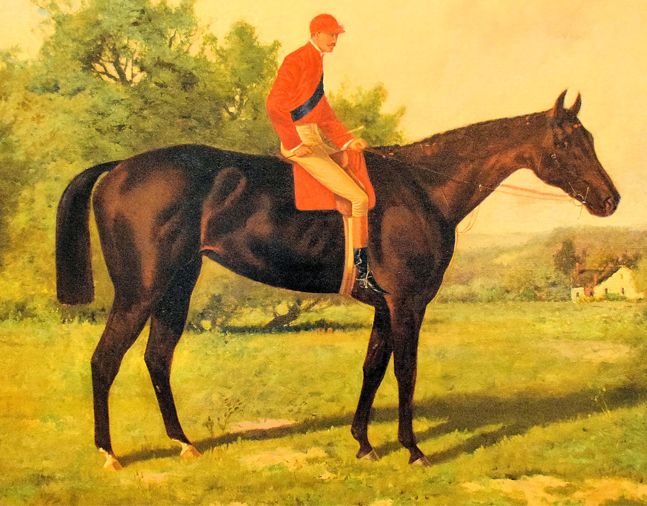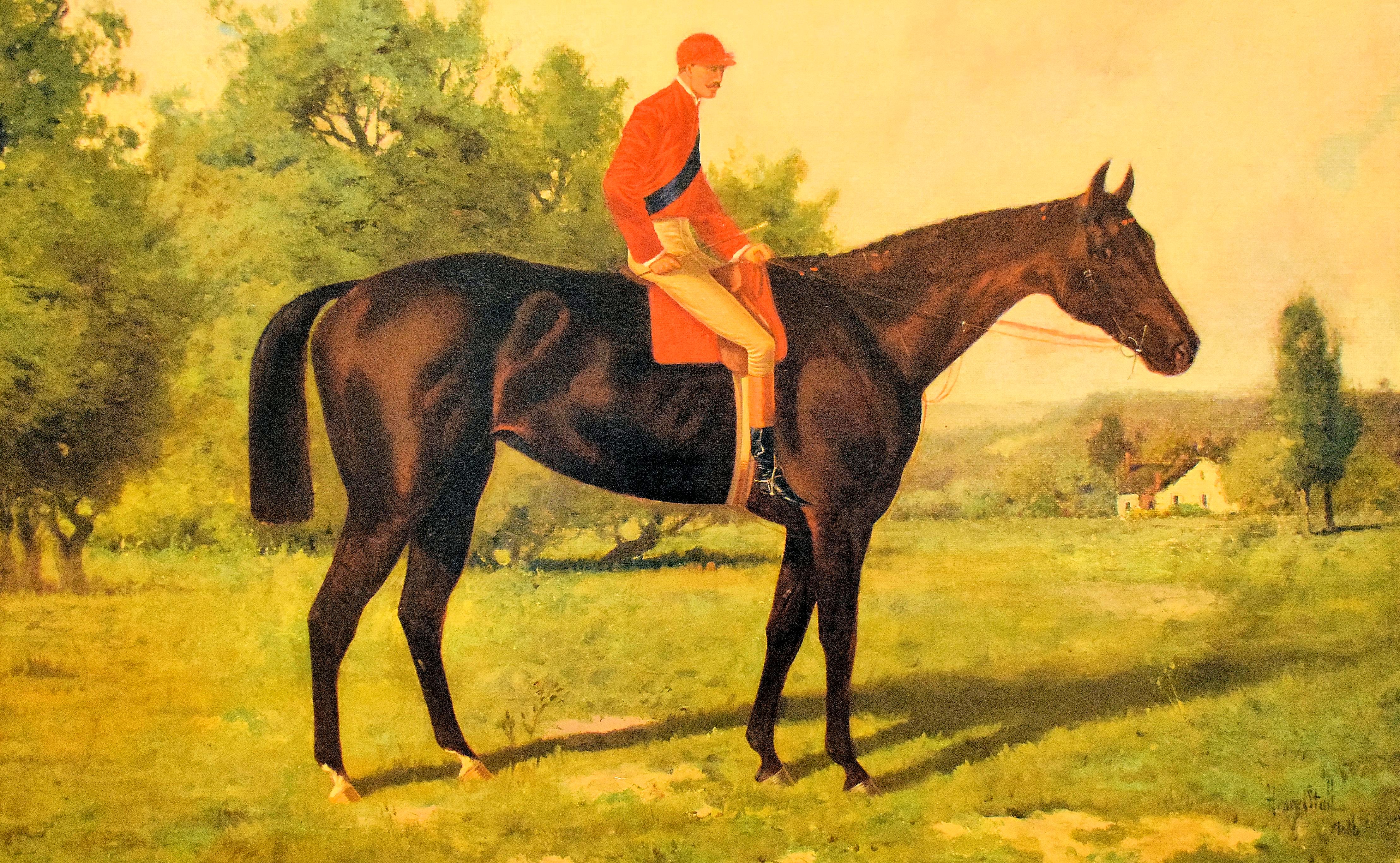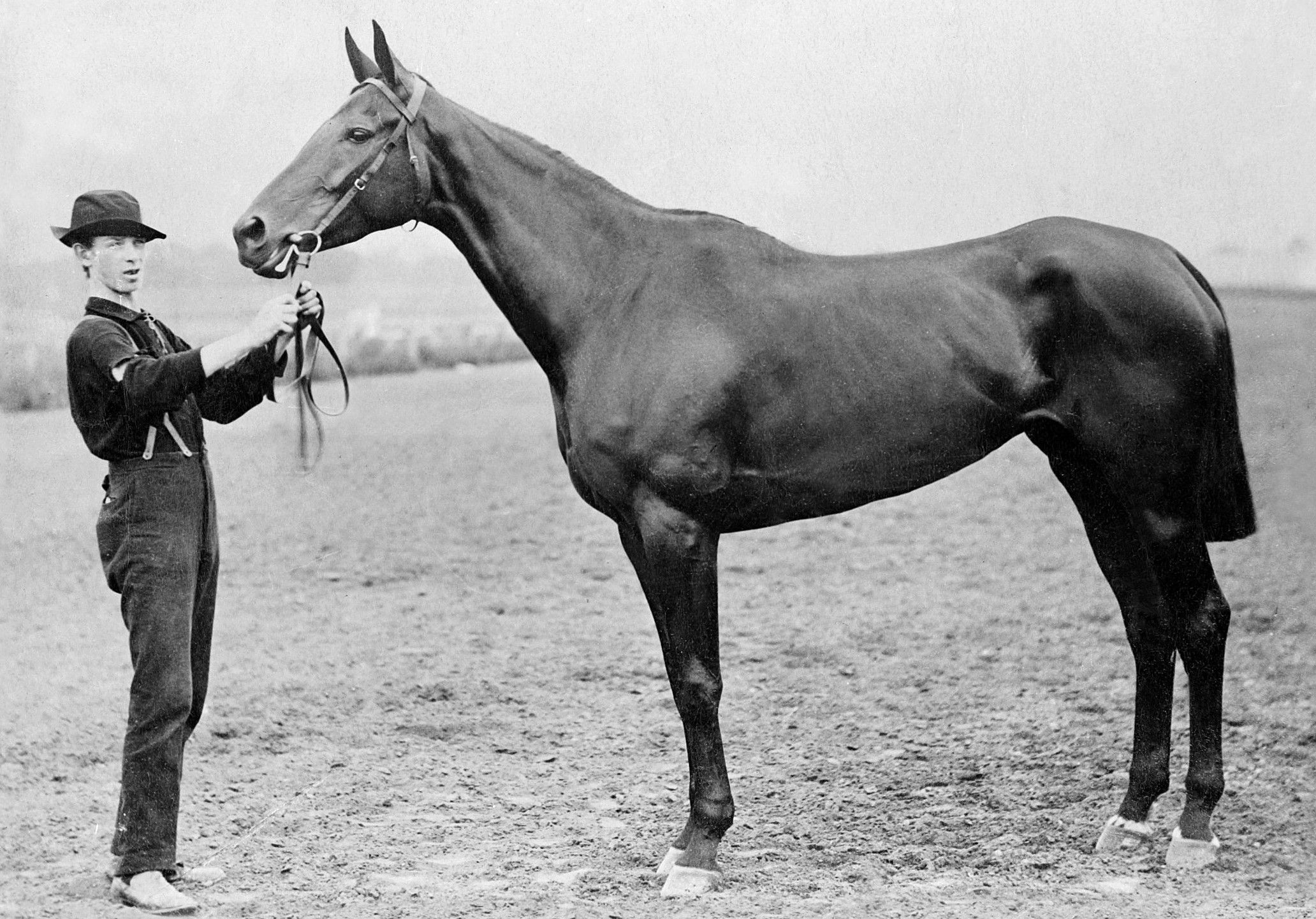Miss Woodford (KY)
A champion in each of her five years on the track and the first racehorse to surpass $100,000 in career earnings, Miss Woodford is widely regarded as being among the among the finest American thoroughbreds of the 19th century.

1967
1880
Billet
Fancy Jane
Neil Robinson
George W. Bowen
George W. Bowen
Col. E. F. Clay
Col. Catesby Woodford
Dwyer Bros. Stable
J. Hannigan
James Rowe, Sr.
Frank McCabe
1882-1886
$118,270
Racing Record
48
Starts
| 1882 | 8 | 5 | 1 | 2 | $6600 $6,600 |
| 1883 | 12 | 10 | 1 | 0 | $51230 $51,230 |
| 1884 | 9 | 9 | 0 | 0 | $21070 $21,070 |
| 1885 | 12 | 7 | 4 | 0 | $19370 $19,370 |
| 1886 | 7 | 6 | 1 | 0 | $20000 $20,000 |
Biography
A champion in each of her five years on the track and the first racehorse to surpass $100,000 in career earnings, Miss Woodford is widely regarded as being among the finest American thoroughbreds of the 19th century.
According to legend, Miss Woodford was bred by Col. Ezekiel F. Clay and Col. Catesby Woodford at Runnymede Stud near Paris, Kentucky. Clay and Woodford had purchased Miss Woodford’s dam, Fancy Jane, from George W. Bowen for a barrel of whiskey. Bowen, however, failed to notify Col. Sanders D. Bruce, compiler of the fourth and fifth editions of the "American Stud Book," of Fancy Jane’s sale and therefore remains listed as the breeder of record.
In any case, Col. Woodford named the filly after his sister, Maria Woodford, and she raced for Bowen, Clay, and Col. Woodford as a 2-year-old in 1882 under the care of trainer J. Hannigan. In her career debut, Miss Woodford won the Ladies Stakes at the Chicago Driving Park. She then finished second to Col. Milton Young’s Ascender in the Nursery Stakes. Shipped to Saratoga, Miss Woodford was third in the Flash Stakes before winning four in a row: the Spinaway Stakes and Misses’ Stakes at Saratoga and the Filly Stakes and Colt and Filly Stakes at the Lexington Association track. In her final start of the year, Miss Woodford finished third in the Blue Grass Stakes at Churchill Downs.
Prior to her 3-year-old campaign, Miss Woodford was traded to Mike and Phil Dwyer. The Dwyers gave up Hall of Famer Hindoo (who was retired) and the fillies Red-and-Blue and Francesca that they valued at $15,000, for Miss Woodford and $9,000, placing her value at $6,000.
The Dwyer brothers put Miss Woodford in the care of Hall of Fame trainer James Rowe. She made her 3-year-old debut on June 5, 1883, at Jerome Park, winning the Ladies Stakes at 1½ miles. Miss Woodford then won the Mermaid Stakes by six lengths, Monmouth Oaks by 10, and the Alabama Stakes by four. After a loss in the Pocahontas Stakes at Saratoga, Miss Woodford faded to last in the Monmouth Stakes, the first of only two times in her career she finished out of the money.
After the Monmouth Stakes, Miss Woodford won 16 consecutive races, a streak that continued into 1885. The string started on Sept. 13, 1883, with a 10-length victory in the Great Eastern Handicap. She then won the Lorillard Champion Stallion Stakes at Churchill Downs by 20 lengths, the Hunter Stakes at Jerome Park by eight lengths, the District of Columbia Stakes at Washington, D.C., by 10 lengths, and the Pimlico Stakes by three lengths against an accomplished field that included George Kinney, Iroquois, and Drake Carter. Miss Woodford concluded her 3-year-old season with a record of 10-1-0 from 12 starts and earnings of $51,230.
At 4, Miss Woodford won all nine of her starts and earned $21,070. Her victories included the Coney Island Stakes, Ocean Stakes, Eatontown Stakes, Champion Stakes, Great Long Island Stakes, and a 2½-mile match race against Drake Carter for $5,000 a side with $2,000 added by the Coney Island Jockey Club. In the Great Long Island Stakes, Miss Woodford defeated Kentucky Oaks and American Derby winner Modesty in consecutive two-mile heats. Miss Woodford won the second heat in 3:31¼, establishing an American record for the distance.
Miss Woodford continued to thrive early in her 5-year-old campaign in 1885. She won the Coney Island Stakes by a length, giving the exceptional filly Wanda 19 pounds, for her 16th consecutive victory. She finally lost in the Farewell Stakes to Thackeray, the beneficiary of nine less pounds than Miss Woodford. Following the loss, Miss Woodford won the Ocean Stakes, Monmouth Cup, and Freehold Cup in succession to make it 19 out of 20 and become America’s greatest money winner.
Miss Woodford, however, was wearing down during the grueling and ambitious campaign set forth by the Dwyers. On Aug. 6, 1885, she finished fourth in the Eatontown Stakes then was defeated by a length by Ed Corrigan’s Freeland in the Champion Stakes only four days later. Miss Woodford met Freeland again eight days later in the Special Stakes and was beaten by a head. The Dwyers immediately challenged Corrigan to a match, $2,500 a side, with $2,500 added by Monmouth Park, and two days later the pair came out again with Miss Woodford delivering a gutsy effort to win by a head at 1¼ miles.
At this time, Rowe wanted to rest Miss Woodford for the remainder of the year. The Dwyers decided to keep her racing and Rowe quit as trainer. His foreman, Frank McCabe, then took over as trainer. Three weeks after Rowe quit, Miss Woodford was beaten by four lengths by Freeland in a sweepstakes at Brighton Beach. Miss Woodford raced once more as a 5-year-old, winning the Great Long Island Stakes in straight heats against mediocre competition.
Miss Woodford won six of seven starts as a 6-year-old in 1886, earning an even $20,000. After a victory in the Harlem Stakes at Jerome Park, Miss Woodford was shipped to St, Louis for the Eclipse Stakes on June 7. At $10,600, it was the biggest purse she ever ran for. The race also drew Modesty and Lucky Baldwin’s Volante, winner of 35 races, including the American Derby and Saratoga Cup. When Miss Woodford took the lead with a half-mile remaining in the 1½-mile contest, she literally brought the house down. Spectators crammed into the press box to get a better view and the whole viewing stand caved in. Miss Woodford, however, was oblivious to those events and won easily, surpassing $100,000 in career earnings in the process.
Ten days later, Miss Woodford was back in New York at Sheepshead Bay for the 1¾-mile Coney Island Cup. After the first quarter-mile, she hooked up with Barnum and the two ran inseparably the rest of the way, resulting in a dead heat. Miss Woodford was then three-quarters of a length short against Suburban Handicap winner Troubadour in a $5,000 match race before winning three more times, taking in succession the Ocean Stakes for the third consecutive year, Monmouth Cup for the second time, and the First Sweepstakes at Saratoga.
The $1,000 First Sweepstakes was Miss Woodford’s final race. She came up lame and was sold by the Dwyers to James Ben Ali Haggin. In all, Miss Woodford ran 48 times with a record of 37-7-2 and earnings of $118,270. She went on to produce stakes winners George Kessler and Sombre, as well as three other winners from nine foals.
Some of the sport’s most accomplished and respected trainers of all time, including James "Sunny Jim" Fitzsimmons, James Rowe, T. J. Healey, A. J. Joyner, and R. W. Walden, considered Miss Woodford the greatest filly or mare they ever saw.
Miss Woodford died in 1899 at the age of 19 at Elmendorf Farm near Lexington, Kentucky.
Achievements
Champion 2-Year-Old Filly — 1882
Horse of the Year — 1883
Champion 3-Year-Old Filly — 1883
Horse of the Year — 1884
Champion Handicap Female — 1884
Champion Handicap Female — 1885
Champion Handicap Female — 1886
Media







